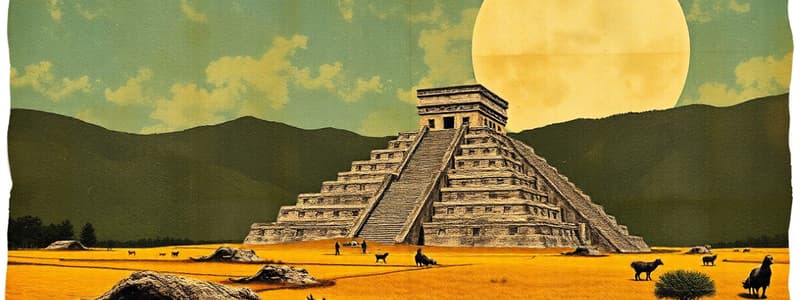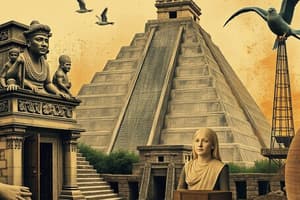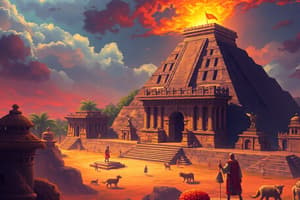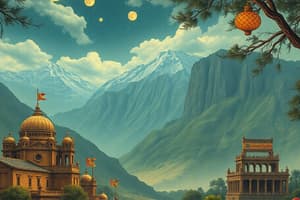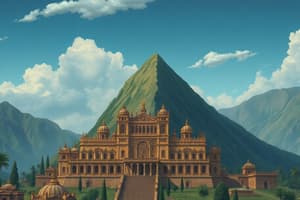Podcast
Questions and Answers
What countries are located in the Inca Empire?
What countries are located in the Inca Empire?
- Ecuador
- Peru
- Bolivia
- Chile
- Columbia
- Argentina
- All of the above (correct)
What god is gold associated with in the Inca Empire?
What god is gold associated with in the Inca Empire?
Inti
Were the walls and buildings of the Inca empire covered in sheets of gold?
Were the walls and buildings of the Inca empire covered in sheets of gold?
True (A)
What is Machu Pichu?
What is Machu Pichu?
Quinoa is native to where?
Quinoa is native to where?
What did Alexander Humboldt say about Quinoa?
What did Alexander Humboldt say about Quinoa?
What are chuños?
What are chuños?
Over 4,000 varieties of potatoes were used by the Inca, which forbade peeling a potato
Over 4,000 varieties of potatoes were used by the Inca, which forbade peeling a potato
After the conquest of the Inca Empire, the Spanish brought the potato to Europe in the 16th century.
After the conquest of the Inca Empire, the Spanish brought the potato to Europe in the 16th century.
What ailments did most of Europe regard potatoes as causing?
What ailments did most of Europe regard potatoes as causing?
In France, who examined the famine relieving properties of the potato?
In France, who examined the famine relieving properties of the potato?
Farmers stole the potatoes and grew them on their own land.
Farmers stole the potatoes and grew them on their own land.
Squash originated in where?
Squash originated in where?
Corn stalks grew straight up, acting as what to support the beans?
Corn stalks grew straight up, acting as what to support the beans?
The Aztecs very powerful, skilled engineers, built roads above the lake water, drained swamps.
The Aztecs very powerful, skilled engineers, built roads above the lake water, drained swamps.
What is Vanilla?
What is Vanilla?
Which country is currently #1 producer of Chilies?
Which country is currently #1 producer of Chilies?
In the centre of pre-Colombian North America, a city of huge pyramids rose from the flat lands on the banks of what river?
In the centre of pre-Colombian North America, a city of huge pyramids rose from the flat lands on the banks of what river?
Cahokia aligned with the rising and setting of what?
Cahokia aligned with the rising and setting of what?
What is succotash?
What is succotash?
What was the role of 'fogon'?
What was the role of 'fogon'?
In the triangle trade, what did the Caribbean provide?
In the triangle trade, what did the Caribbean provide?
What is the name of the nuclear conflict climax of the Cold War?
What is the name of the nuclear conflict climax of the Cold War?
What is fading in America?
What is fading in America?
What is the norm in America?
What is the norm in America?
Flashcards
The Inca Empire
The Inca Empire
The empire in South America known as the Sky People.
Terraced Farming
Terraced Farming
Farming on stepped platforms built into mountainsides
Quinoa
Quinoa
A resilient grain native to the Andes, high in protein.
Potato
Potato
Signup and view all the flashcards
Potato introduction to Europe
Potato introduction to Europe
Signup and view all the flashcards
Antoine-Auguste Parmentier
Antoine-Auguste Parmentier
Signup and view all the flashcards
Squash Origin
Squash Origin
Signup and view all the flashcards
Three Sisters Farming
Three Sisters Farming
Signup and view all the flashcards
Chinampas
Chinampas
Signup and view all the flashcards
Vanilla
Vanilla
Signup and view all the flashcards
Corn
Corn
Signup and view all the flashcards
Huitlacoche
Huitlacoche
Signup and view all the flashcards
Cacao Tree
Cacao Tree
Signup and view all the flashcards
Chile peppers Origin
Chile peppers Origin
Signup and view all the flashcards
Scoville Units
Scoville Units
Signup and view all the flashcards
Cahokia
Cahokia
Signup and view all the flashcards
Columbian Exchange
Columbian Exchange
Signup and view all the flashcards
Hardtack
Hardtack
Signup and view all the flashcards
Smallpox
Smallpox
Signup and view all the flashcards
Triangle Trade
Triangle Trade
Signup and view all the flashcards
US Founding date
US Founding date
Signup and view all the flashcards
Civil Rights Movement
Civil Rights Movement
Signup and view all the flashcards
Civil War
Civil War
Signup and view all the flashcards
Slave Trade Act
Slave Trade Act
Signup and view all the flashcards
Immigration
Immigration
Signup and view all the flashcards
Melting Pot
Melting Pot
Signup and view all the flashcards
Religion
Religion
Signup and view all the flashcards
Southwest
Southwest
Signup and view all the flashcards
Boston brown bread
Boston brown bread
Signup and view all the flashcards
Soft Drinks
Soft Drinks
Signup and view all the flashcards
Study Notes
- Includes South and Central Americas, and the United States of America
Pre-Columbian America
- World cuisine's impact on North America requires understanding pre-Columbian foods.
- Pre-Columbian American Empires include the Inca, Aztecs, and Cahokia.
The Inca (South America)
- Inca Empire included modern-day Ecuador, Peru, Bolivia, Chile, Columbia, and Argentina.
- Inti was the god of the sun; gold was believed to be the "sweat of the sun".
- The Inca built walls and buildings covered in gold sheets.
- Much of the gold was melted down by Spanish conquistadores.
- Machu Pichu was discovered in 1911.
- The Inca used terraced farming techniques.
Quinoa
- Quinoa is referred to as the 'mother grain'.
- It is native to the Andes and high in protein.
- It serves as a good protein source for vegetarians.
- German scientist Alexander Humboldt said quinoa was to the Greeks what wine was, wheat was to the Romans, and cotton to the Arabs 200 years ago.
- Quinoa's resilience to droughts and poor soil could help boost global food security, according to the UN's Food and Agriculture Organization.
Potato
- Potatoes were domesticated in Peru between 3700 & 3000 BC.
- The Inca used over 4,000 potato varieties forbidding peeling.
- The Inca invented freeze-dried potatoes (chuños) as insurance against food shortages.
- Varieties of root crops, the potato, captured world attention as a significant source of carbohydrates.
- Protein shortages were not uncommon.
- After the conquest of the Inca Empire, the Spanish brought potatoes to Europe in the 16th century.
- Europeans regarded potatoes as dangerous believing they caused ailments.
- Antoine-Auguste Parmentier, a chemist and botanist, examined the famine-relieving properties of the potato in France, 1771.
- Parmentier convinced Louis XVI to grow potatoes in closely guarded fields.
- French farmers eventually stole the potatoes and grew them on their own land.
- Squash originated in Bolivia and neighboring regions as early as 500 BC.
Other Fruit
- Wide variety of fruits are indigenous to the Andes gradually appearing in North America.
- These include Cape gooseberry, pepino, tamarillo, cherimoya, giant Colombian blackberry, and inga pods (or ice cream bean).
The Aztecs and Mayans (Central America)
- The Mayans farmed efficiently by combining corn, bean, and squash - known as the 'three sisters farming'.
- Corn stalks grew straight up acting as a trellis to support beans.
- Squash plant's broad leaves kept moisture in the soil.
- Bees appeared throughout the codices; cinnamon, cloves, nutmeg, and allspice were used for seasoning.
- The Aztecs built their capital city, Tenochtitlan [ten-OHCH-teet-lahn] on an island in the middle of a lake because of a spiritual sign.
- They were powerful, skilled engineers, built roads above the lake water, and drained swamps.
- They invented chinampas, land and irrigation ditches that looked like floating fields.
Vanilla
- Vanilla is the only edible member of the orchid family, originating in the lowland tropical forests of Central America & northern South America.
- Vanilla was used to perfume temples like Europeans used cinnamon in the Middle Ages.
- It grows on vines that climb supporting trees, called 'tutor' trees.
- The flower opens for only 8 hours and must be hand-pollinated.
- The vine produces long green pods nine months later.
Corn
- Corn was used to describe any grain, like barley or wheat.
- Maize came from the Spanish, who learned it from the indigenous Caribbean tribes.
- Corn was domesticated in central Mexico by 3400 BCE.
- It became a basic crop spreading north into the American southwest and south to the Inca empire.
- "Mexican Truffles"Huitlacoche [wheat-la-COH-chay] is a fungus that grows on the ear of corn.
- Huitlacoche is considered a delicacy when it starts out white then turns black.
- Farmers consider it a blight destroying the corn. Their term for it is just corn smut!
Cacao Tree
- Among the most important trees believed to spring from the maize god's body.
- Chocolate was the beverage of nobles, warriors, and Aztec emperors, served after banquets with tobacco for male bonding.
- Chile peppers are the number one spice in the world.
- They originated in Bolivia 7,000 years ago, and were domesticated 4,000 years ago.
- The Inca, Maya, and Aztecs of the American Southwest seasoned their food with chile peppers.
- After the Columbian Exchange, many chili pepper cultivars spread worldwide, used for food and traditional medicine.
- China is the current #1 overall producer making half the world supply.
- Chili peppers were brought to Spain in 1493, with literature on their medicinal effects.
- Chilies were grown as botanical curiosities in monasteries.
- Christian monks experimented with the culinary potential of chile peppers finding pungency offered as a substitute for black peppercorns.
- Chili peppers spread to Asia with Portuguese traders.
- The spice trade routes were then dominated by Portuguese and Arab traders.
- Portuguese introduced chile peppers in India around the end of 15th century.
- Today chillies are staples in Indian and Southeast Asian cuisines.
North America: Cahokia
- A prominent city rose in pre-Columbian North America located on the Mississippi River's flatlands, east of present-day St. Louis, around 700 CE.
- The city had 100 flat top pyramid mounds, aligned with sunrises, sunsets, and constellations.
- Cahokia reached a population between 10,000 and 20,000 and, in 1250, London, England.
- Some historians believe the city was wiped out by European diseases.
- By the time Americans had reached the Mississippi in the 18th century, Cahokia was abandoned, like the Inca and Aztecs.
- The population by 1900 was under 300,000.
- Native Americans experienced violence and cultural destruction.
- Europeans paid settlers for each killed.
- Food systems decimated, residential schools destroyed families/culture.
- Civil rights violations and discrimination continue in the 20th century.
- Common Native American foods include succotash, bean bread, fry bread, baked acorn squash, fish and corn mush, and baked beans.
The Columbian Exchange
- The standard Spanish food consisted mostly of dried or salted items: rice, dried chickpeas, beef, pork, anchovies, and sardines preserved in salt.
- Each man was provided casks of olive oil and 1 1/2 liters per day of wine.
- Hardtack, an unleavened, hard flour, water, and salt biscuit, was served as a staple.
- Fresh fish supplemented meals with officers receiving dried fruit if available and no vegetables given.
- Since there was no cook on board, the crew took turns cooking midday meals over a fogon, an open iron box.
- A simplified map of the world showing all of the continents connected.
- Aboriginals lacked immunity to common colds causing devastating population annihilations.
- Smallpox, carried by a member of Columbus's crew, spread like wildfire causing devastations.
- Estimates are that indigenous American population at European contact in 1492 totaled at 10 to 113 million people where pre-contact was highest.
Items From Europe, Africa & Asia to the Americas
- Animals: Cat, Cattle, Chicken, Dog, Donkey
- Grains & Legumes: Barley, Chickpeas, Lentil, Oats, Rice
- Vegetables, Herbs, Spices & Fruits: Lettuce, Mustard, Nutmeg, Onion, Parley
- From The Americas To Europe
- Animals: Turkey, Muscovy Duck
- Vegetables & spices: Allspice, Amaranth, Jicama, Peppers
- Fruits: Avocado, Blueberry, Cranberry, Tomato
- The introduction of chocolate, coffee, and tea into the Americas caused a demand for sugar; its availability increased their demand.
- What had been a medicine for the rich in the Middle Ages became a staple for the poor by the middle of the eighteenth century.
- The Caribbean was linked to two routes.
Triangle Trade
- The Caribbean trade consisted of sugar and rum from the Caribbean to Europe.
- It also consisted of goods from Europe to Africa, as well as slaves from Africa to the Caribbean. The American trade shipped molasses from the Caribbean to New England, processed into rum, and traded for enslaved Africans. Slaves were shipped to and sold in the Caribbean as part of the molasses circuit back to New England.
The United States
- The USA - The 13 original British colonies.
- Key founding fathers include George Washington, John Adams, and Thomas Jefferson
- The American Revolution began in April 1775 and ended in 1783. On July 4, 1776, the Declaration of Independence, drafted by Thomas Jefferson, was delivered to Great Britain.
- Civil War 1861-1865 addressed State rights vs. federal rights, slavery, and abolitionism.
Key Dates in US History
- War of 1812: against the British to cutoff supply lines to the French
- World War I & II
- 1960 Civil Rights Movement, 1964 segregation stopped
- 1961 Cuba and U.S.A. – nuclear conflict climax of the Cold War
- 1961 Man in space
- 1963 death of John F. Kennedy
- Vietnam war 1962
Slavery in British North America (Canada)
- Slavery existed throughout North America, South America, and the Caribbean, including British North America from the 1500's through the 1800's.
- Over 4,000 enslaved Africans were forcibly sent to present-day Canada.
- As early as 1793, Upper Canada, now Ontario, gradually ended slavery.
- The British Empire abolished the Slave Trade in 1807 and Slavery by 1834.
- Because it abolished slavery, Upper Canada, now Ontario, was sought after by formerly enslaved.
- Windsor, Kingston, and Niagara served as terminuses of the underground railroad.
- Around 30-40 thousand formerly enslaved Americans reached between 1800 – 1860 Canada.
- Buxton Ontario is an Underground Railroad settlement called the most successful of refuges for black escaping slavery.
- Civil Rights and African American culture significantly influence American foodways and culture.
Demographic and Ethical Shifts
- Rapid infusion of people expanded religious exposure.
- Holiday spectrum is broadening and regional food specialties are fading.
- Fusion foods are the new norm narrowing rural and urban foodways.
Regional Cuisines
- Northeast: Native Americans, Pilgrims, British Isles
- Southern: England, Africa, France, Spain, Caribbean
- Midwest: Britain, Scandinavian, German, Italian
- Southwest: Spanish, Mexico
Regional Specialities
- Northeast: Boston brown bread, Boston cream pie, apple pie, Boston/Manhattan clam chowder, Grits, and Red-eye gravy.
- South: Hush puppies, Pralines, Cajun cuisine, Gumbo, and Tortilla.
Regional Beverages
- Coffee, soft drinks, beer, bourbon
- The leading fast food chains by sales in 2016 were, in order, McDonald's, Starbucks Coffee, Subway, Taco Bell, and Burger King.
Studying That Suits You
Use AI to generate personalized quizzes and flashcards to suit your learning preferences.
